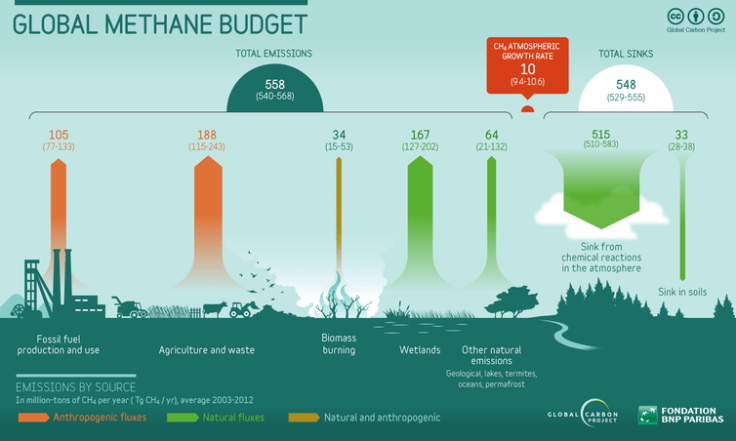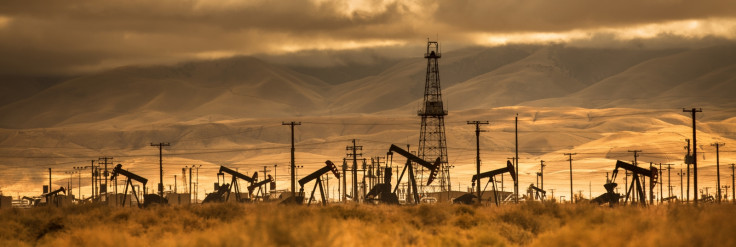A dangerous climate wildcard: Surge in methane placing the planet in uncharted territory
Upward trend of methane concentrations in the atmosphere is bad news - but it also presents an opportunity.

Pep Canadell, CSIRO; Ben Poulter, NASA; Marielle Saunois, Institut Pierre-Simon Laplace; Paul Krummel, CSIRO; Philippe Bousquet, Université de Versailles Saint-Quentin en Yvelines – Université Paris-Saclay , and Rob Jackson, Stanford University
Methane concentrations in the atmosphere are growing faster than any time in the past 20 years. The increase is largely driven by the growth in food production, according to the Global Methane Budget released today. Methane is contributing less to global warming than carbon dioxide (CO₂), but it is a very powerful greenhouse gas.
Since 2014, methane concentrations in the atmosphere have begun to track the most carbon-intensive pathways developed for the 21st century by the Intergovernmental Panel on Climate Change (IPCC).
The growth of methane emissions from human activities comes at a time when CO₂ emissions from burning fossil fuels have stalled over the past three years.
If these trends continue, methane growth could become a dangerous climate wildcard, overwhelming efforts to reduce CO₂ in the short term.

In two papers published today (see here and here), we bring together the most comprehensive ensemble of data and models to build a complete picture of methane and where it is going – the global methane budget. This includes all major natural and human sources of methane, and the places where it ends up in methane "sinks" such as the atmosphere and the land.
This work is a companion effort to the global CO₂ budget published annually, both by international scientists under the Global Carbon Project.
Where does all the methane go?
Methane is emitted from multiple sources, mostly from land, and accumulates in the atmosphere. In our greenhouse gas budgets, we look at two important numbers.
First, we look at emissions (which activities are producing greenhouse gases).
Second, we look at where this gas ends up. The important quantity here is the accumulation (concentration) of methane in the atmosphere, which leads to global warming. The accumulation results from the difference between total emissions and the destruction of methane in the atmosphere and uptake by soil bacteria.
CO₂ emissions take centre stage in most discussions to limit climate change. The focus is well justified, given that CO₂ is responsible for more than 80% of global warming due to greenhouse gases. The concentration of CO₂ in the atmosphere (now around 400 parts per million) has risen by 44% since the Industrial Revolution (around the year 1750).

While CO₂ in the atmosphere has increased steadily, methane concentrations grew relatively slowly throughout the 2000s, but since 2007 have grown ten times faster. Methane increased faster still in 2014 and 2015.
Remarkably, this growth is occurring on top of methane concentrations that are already 150% higher than at the start of the Industrial Revolution (now around 1,834 parts per billion).
The global methane budget is important for other reasons too: it is less well understood than the CO₂ budget and is influenced to a much greater extent by a wide variety of human activities. About 60% of all methane emissions come from human actions.
These include living sources – such as livestock, rice paddies and landfills – and fossil fuel sources, such as emissions during the extraction and use of coal, oil and natural gas.
We know less about natural sources of methane, such as those from wetlands, permafrost, termites and geological seeps.
Biomass and biofuel burning originates from both human and natural fires.
Given the rapid increase in methane concentrations in the atmosphere, what factors are responsible for its increase?
Uncovering the causes

Scientists are still uncovering the reasons for the rise. Possibilities include: increased emissions from agriculture, particularly from rice and cattle production; emissions from tropical and northern wetlands; and greater losses during the extraction and use of fossil fuels, such as from fracking in the United States. Changes in how much methane is destroyed in the atmosphere might also be a contributor.
Our approach shows an emerging and consistent picture, with a suggested dominant source along with other contributing secondary sources.
First, carbon isotopes suggest a stronger contribution from living sources than from fossil fuels. These isotopes reflect the weights of carbon atoms in methane from different sources. Methane from fossil fuel use also increased, but evidently not by as much as from living sources.
Second, our analysis suggests that the tropics were a dominant contributor to the atmospheric growth. This is consistent with the vast agricultural development and wetland areas found there (and consistent with increased emissions from living sources).
This also excludes a dominant role for fossil fuels, which we would expect to be concentrated in temperate regions such as the US and China. Those emissions have increased, but not by as much as from tropical and living sources.
Third, state-of-the-art global wetland models show little evidence for any significant increase in wetland emissions over the study period.
The overall chain of evidence suggests that agriculture, including livestock, is likely to be a dominant cause of the rapid increase in methane concentrations. This is consistent with increased emissions reported by the Food and Agriculture Organisation and does not exclude the role of other sources.
Remarkably, there is still a gap between what we know about methane emissions and methane concentrations in the atmosphere. If we add all the methane emissions estimated with data inventories and models, we get a number bigger than the one consistent with the growth in methane concentrations. This highlights the need for better accounting and reporting of methane emissions.
We also don't know enough about emissions from wetlands, thawing permafrost and the destruction of methane in the atmosphere.
The way forward

At a time when global CO₂ emissions from fossil fuels and industry have stalled for three consecutive years, the upward methane trend we highlight in our new papers is unwelcome news. Food production will continue to grow strongly to meet the demands of a growing global population and to feed a growing global middle class keen on diets richer in meat.
However, unlike CO₂, which remains in the atmosphere for centuries, a molecule of methane lasts only about 10 years.
This, combined with methane's super global warming potency, means we have a massive opportunity. If we cut methane emissions now, this will have a rapid impact on methane concentrations in the atmosphere, and therefore on global warming.
There are large global and domestic efforts to support more climate-friendly food production with many successes, ample opportunities for improvement, and potential game-changers.
However, current efforts are insufficient if we are to follow pathways consistent with keeping global warming to below 2℃. Reducing methane emissions needs to become a prevalent feature in the global pursuit of the sustainable future outlined in the Paris Agreement.
Pep Canadell, CSIRO Scientist, and Executive Director of the Global Carbon Project, CSIRO; Ben Poulter, Research scientist, NASA; Marielle Saunois, Enseignant chercheur à l'Université de Versailles Saint Quentin; chercheur au Laboratoire des Sciences du Climat et de l'Environnement, Institut Pierre-Simon Laplace; Paul Krummel, Research Group Leader, CSIRO; Philippe Bousquet, Professeur à l'université de Versailles Saint-Quentin en Yvelines, chercheur au Laboratoire des sciences du climat et de l'environnement (LSCE), membre de l'Institut de France, auteur contributif d'un chapitre des deux derniers rapports du GIEC, Université de Versailles Saint-Quentin en Yvelines – Université Paris-Saclay , and Rob Jackson, Professor, Earth System Science and Chair of the Global Carbon Project, Stanford University
This article was originally published on The Conversation. Read the original article.
© Copyright IBTimes 2025. All rights reserved.





















